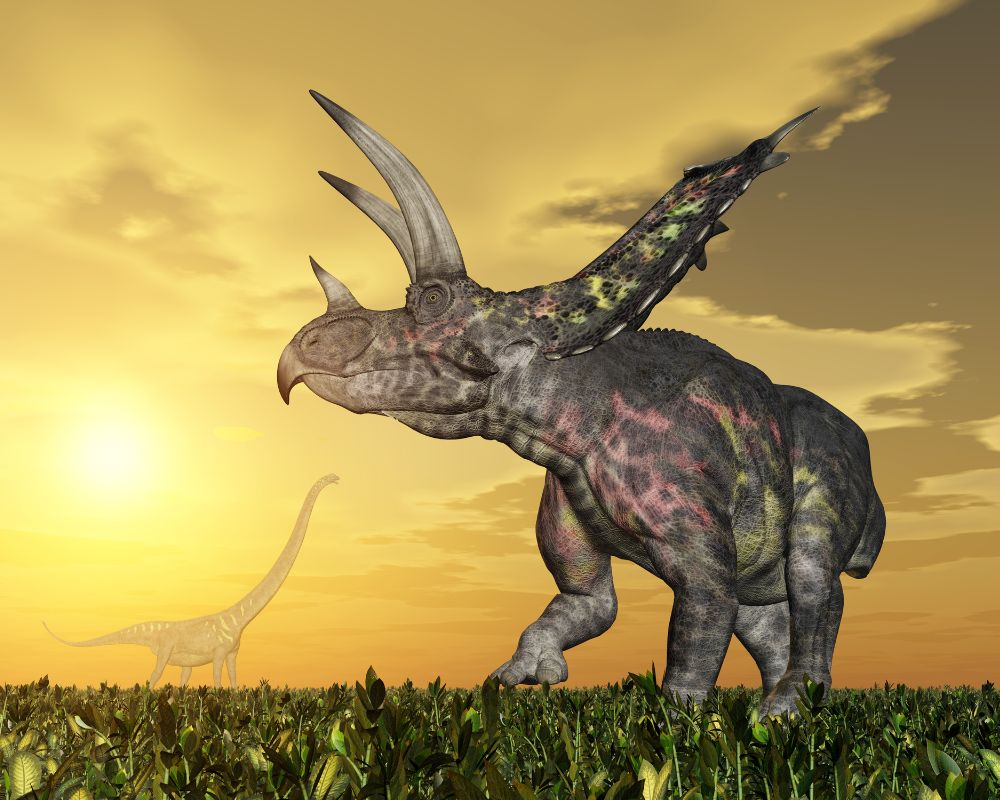Pentaceratops and Styracosaurus were giant horned dinosaurs that roamed the Western parts of North America during the Late Cretaceous period. They moved in herds with other herbivores, and fights were common. Unlike battles between Triceratops vs. Styracosaurus, Styracosaurus vs. Pentaceratops didn’t have an obvious winner.
Table of Contents
Battle Facts about Pentaceratops vs. Styracosaurus

| Name | Pentaceratops (Pentaceratops sternbergii) | Styracosaurus (Styracosaurus albertensis) |
| Size | 20-28 feet long, 6-8 feet tall at the shoulder | 16-18 feet long, 5-6 feet tall at the shoulder |
| Speed | 20 mph | 20 mph |
| Offense | Moved in herds, two long forward-facing horns for battle | Moving in herds, horns surrounding the head |
| Defense | Frills and long horns, strong | Frills and nose horn, strong |
| Endurance and Behavior | Lived in herds and grazed constantly | Grazing in herds and constant movement in open areas |
Pentaceratops and Styracosaurus were two massive Ceratopsian dinosaurs. Even though they were herbivores, these dinos would fight, using their nose horns like rhinos.
While the much larger Triceratops would win against these two dinos easily, Pentaceratops and Styracosaurus more equally matched with each other.
Were Pentaceratops and Styracosaurus Related?
The Pentaceratops and the Styracosaurus were related to each other. They were part of the Ceratopsid family. This group of dinos had beaks, horns, and frills.
There were many dinos in the Ceratopsian dinosaurs, including:
- Centrosaurus
- Chasmosaurus
- Triceratops
- Torosaurus
These Ceratopsian dinosaurs could be found together in a herd where their territories overlapped. Other herbivores like Parasaurolophus, Pachycephalosaurus, and Ankylosaurus also moved in mixed herds.
Even though most of these dinos were peaceful, fights still broke out over food, mates, and space.
What was the Difference Between a Pentaceratops and a Styracosaurus?
The horns and spikes of Pentaceratops and Styracosaurus were different. Pentaceratops’ name means “five-horned face,” given to it because of its horns. Styracosaurus is called the “spiked lizard” because of the spikes from the side of its face and the top of its frill.
Styracosaurus was also 400 pounds heavier than the 5500-pound Pentaceratops. That doesn’t seem like a lot, but it helps a dino become faster due to less weight.
Who was stronger – the Styracosaurus or the Pentaceratops?

The heavier Styraco was actually a little bit stronger. With shorter, thicker legs, Styraco could shove Pentaceratops with more force. Since both dinos could reach speeds of 20mph, Styraco could exert 5,300 pounds more force than a Pentaceratops.
Still, strength was the only advantage Styracosaurus had over Pentaceratops. Since they both lived around the same time, their adaptations were about equal. Being extra bulky gave Styraco a lot more impact than Pentaceratops.
How did Styracosaurus and Pentaceratops Defend Themselves?
Styracosaurus and Pentaceratops both had nose horns they used in battle. Styracosaurus had a longer nose horn than Pentaceratops, but Rhino-like nose horns weren’t their only defense.
Pentaceratops also had two forward-facing horns over its eyes. These horns were a lot like bull horns. Pentaceratops’ horns were about 3 feet long and could be used to gore an opponent!
Who Would Win, Pentaceratops or Styracosaurus?

Both Pentaceratops and Styracosaurus could win in battle against each other. Pentaceratops had the advantage of long horns, but Styracosaurus was stronger. Both had thick skulls, which protected them if they rammed each other head-on.
If Pentaceratops could pierce the sides or behind the frill of Styracosaurus, Pentaceratops would win. If Styracosaurus used its longer nose horn to pin down and ram into Pentaceratops, then Styraco could win.
Ceratopsian dinosaurs, for the most part, got along well. They were more worried about being eaten by carnivores, like Tyrannosaurus rex and the raptors of North America. Pentaceratops, Styracosaurus, and Triceratops were more likely to use their defenses to beat the mighty T-rex!
